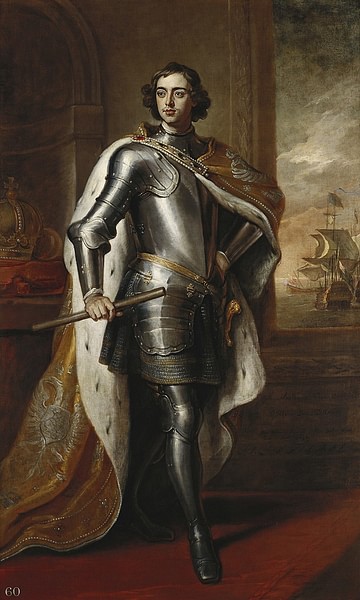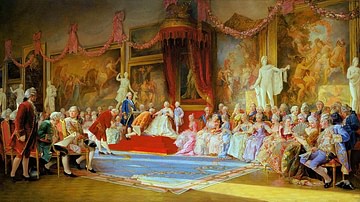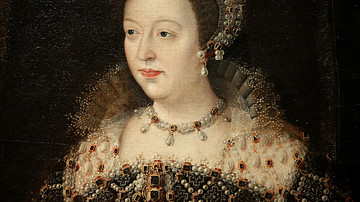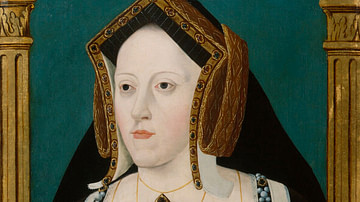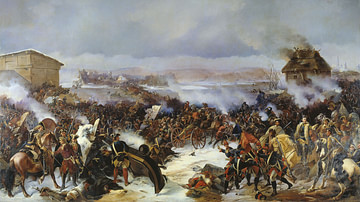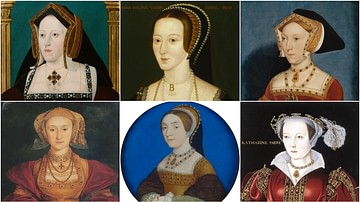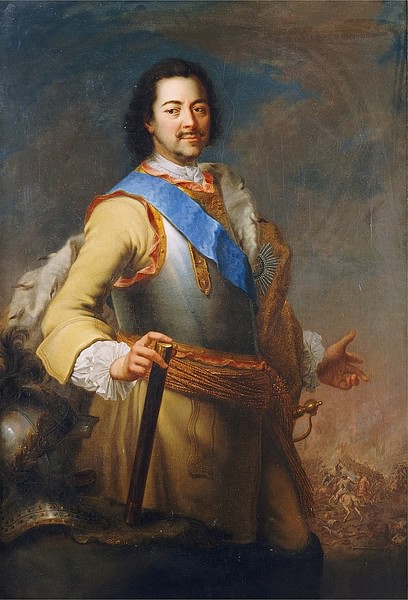
Peter I of Russia (Peter the Great) was the Tsar of Russia from 1682-1721 and Emperor of Russia from 1721-1725. During his long reign, Peter had absolute power and brought real change to Russia, including building its first navy, introducing industrialisation, establishing educational institutions and creating the new Russian capital, St. Petersburg.
Peter loved learning from foreigners, especially during his long trip to Western Europe (the Grand Embassy). This trip allowed him to modernise Russia and put it on equal footing with other powerful and modern European nations.
Childhood & Education
Peter was born in Moscow on 30 May 1672. He was the son of Tsar Alexis (1629-1676) and his second wife Natalya Kirillovna Naryshkina (1651-1694). Although he was the third son of Tsar Alexis, his birth was welcomed with much fanfare as his older half-brothers, Feodor (1661-1682) and Ivan (1666-1696), were both sickly and weak. As thanks for his healthy birth, the Tsaritsa's family were given honours and rose in rank. Peter was christened on 29 June, Saint Peter's feast day in the Russian Orthodox Church.
As a child, Peter was surrounded by luxury and was looked after by a governess, a wet nurse, and a staff of playmates and companions who obeyed his every whim. Peter was educated by Nikita Zotov (1644-1717), who told him epic stories of Russia's past. Zotov made such an impression on Peter that they remained lifelong friends, and Peter swore he would return Russia to its former glory if he became tsar.
The Question of Succession
Tsar Alexis died in January 1676, passing his crown to his oldest surviving son, Feodor, who was only 14. Feodor treated Peter and his mother kindly, perhaps because Peter was too young to pose any real risk to his rule. Feodor died in 1682, but at the time, there was no formal succession law in Russia, with the most common rule being that the oldest son would succeed the tsar. However, Feodor died without heirs, so both Peter and Ivan became contenders for the throne. Although Ivan was older, he was also lame and almost blind, and the boyars (the highest form of nobility in Eastern Europe) generally preferred Peter. The nobles also knew that a regent would hold the real power, and they favoured Peter's foster grandfather, Artamon Matveyev (1625-1682), over Ivan's relative, Ivan Miloslavsky (d. 1681).
After the nobles had farewelled Tsar Feodor, it was decided that the people would choose who would become tsar next. Patriarch Joachim went out to the staircase overlooking Cathedral Square and asked the public who should become the next tsar. It was not long before the cries of support for Peter overtook the support for Ivan, and Peter was proclaimed tsar at only ten years old. At first, Peter refused to accept the title as he believed himself to be too young, but he soon complied.
The Streltsy Revolt
Certain powerful people were unhappy with the new tsar, namely Princess Sophia (1657-1704), Peter's half-sister, who believed that Ivan should have been named tsar instead. Unlike most Russian princesses, Sophia was in the public eye, educated and outspoken, which made her a real threat. At Feodor's funeral, Sophia made a scene, causing Peter and Natalya to make a hasty retreat; this in itself caused criticism.
One of the key players in Russian politics and power was the Streltsy (Russia's first professional soldiers), who guarded the Russian government and royals. They were supported by the tsar, who paid for their food and housing. In May 1682, Sophia's supporters went to the Streltsy and claimed that Peter and his family had killed Ivan. That was all it took for revolt to break out. The Streltsy marched on the Kremlin to accuse Peter and his family of being traitors and murderers.
Natalya was told to show Peter and Ivan to the public so they could see with their own eyes that both boys were alive and well. The Streltsy were confused but stood down after Matveyev (a former Streltsy commander) assured them that all was well. The son of the Streltsy commander, Prince Michael Dolgoruky, foolishly chose this time to berate the Streltsy and take military control. This caused another uproar that resulted in many people being killed, including Matveyev and Natalya's brother Afanasy, with the slain bodies being put on public display.
However, the main target of the Streltsy was Natalya's brother Ivan, who they believed poisoned Feodor and plotted to take the throne. Sophia advised Natalya that turning in her brother would be the only way to save themselves. Natalya knew she was right and summoned Ivan, who then turned himself in. After he was tortured and killed, the Stresltsy were satisfied that all the traitors had been dealt with. The Streltsy Revolt had a lasting impact on Peter, changing how he viewed Moscow, the Russian Orthodox Church, and everything that came with being a royal.
On May 23, 1682, the Streltsy demanded that Peter and Ivan become co-tsars and have a joint rule. The boyars agreed to this request to avoid further bloodshed. On 29 May, a further appeal was made that Sophia become regent. On 6 July, the coronation of Peter and Ivan took place. This coronation was the first time in European history that two male rulers of equal status had been crowned at the same time. During the years of Sophia's regency, Peter and Ivan fulfilled their formal duties. However, for the most part, Peter enjoyed a stress-free childhood.
Regiments & Navy
Peter's education was an unconventional one for a young tsar. He learnt from building things and exploring the outdoors, while his formal education fell by the wayside. One of his favourite ways to pass the time was to play war games. He and his playmates formed military schools where they studied the ways of the military, lived like soldiers and built things. As he grew older, he began to take his games more seriously and ordered weapons. He was well aware that one day, he would rule Russia and need to protect it from its enemies. Peter formed the Preobrazhensky Regiment (the first regiment of the Russian Imperial Guard) and the Semyonovsky Regiment.
At 15, Peter heard about an instrument that could measure distances without moving. He asked Prince Yakov Dolgoruky (c. 1667-1746) to bring one back from Paris after his diplomatic mission there. There was only one problem: nobody knew how to use an astrolabe. They were pointed in the direction of Franz Timmermann, a Dutch merchant who was living in Russia. Timmermann became a close friend of Peter and fuelled his interest in learning geography, geometry and arithmetic.
In June 1688, Peter and Timmermann were walking around an old estate at Ismailovo when Peter asked for a storehouse to be opened. There lay a boat unlike any he had ever seen in Russia. Timmermann informed him that it was an English boat. Peter was amazed that this boat could sail even against the wind and ordered for it to be repaired so he could study it closely. Another Dutchman, Karsten Brandt, fixed the boat. Peter learned how to sail, soon becoming obsessed with his newfound hobby. Peter was determined to build his own navy of ships and set up a shipbuilding operation on the shores of Lake Pleshev. Thus began his lifelong love of the sea.
Marriage & Sophia's Downfall
Before too long, Natalya had called Peter back to Moscow, where it was decided that it was time for him to get married. The marriage took place on 27 January 1689. His bride, Eudoxia Lopukhina (1669-1731), was three years older than Peter, shy, and came from a good, conservative family. It was clear that Peter and Eudoxia were ill-matched from the beginning. Peter was lively and adventurous, while Eudoxia was fearful, uneducated, and overly aware of her husband's title to the point that she was deferential. Despite all this, the couple had three sons together: Alexis (1690-1718), Alexander (1691-1692), and Paul (1693-1693), although only Alexis survived into adulthood.
Peter barely waited for his honeymoon to be over before he was racing back to his shipbuilding; however, Natalya soon called him back to Moscow as tensions were rising in Sophia's administration. Now that Peter had come of age and was married, Sophia knew her position as regent was perilous. Peter refused to acknowledge Sophia's lover and first minister, Prince Vasily Golitsyn (1643-1714), and on 18 July 1689, their tension was put on public display at the celebration of the miraculous appearance of the icon of Our Lady of Kazan after Peter attempted to remove Sophia from the procession. When she refused, Peter left instead and returned to the countryside.
In August 1689, Peter learnt that Sophia was assembling a large number of Streltsy and was falsely informed that she was marching against him. Remembering the horrific bloodshed that took place seven years earlier, Peter fled to the Trinity Lavra of St. Sergius, as it was a strong fortress and one of the holiest places in all of Russia.

Peter summoned the Streltsy colonels to make their way to the monastery. Sophia threatened them and forbade them to go. She instead sent Patriarch Joachim to meet with Peter. This meeting was a mistake, as the Patriarch quickly took Peter's side. Sophia set out for the monastery herself but was convinced to turn back to Moscow. Now desperate, Sophia pled with her supporters and bribed them to keep their allegiance. Meanwhile, Peter ordered all the foreign ministers to come to his side, signalling the real end of Sophia's regency. The Streltsy in Moscow demanded that Sophia give up her close confidant and diplomat, Fyodor Shaklovity (d. 1689), which she reluctantly did, knowing it was the only way to save her life. Sophia was sent to Novodevichy Convent, where she died in 1704.
The Jolly Company
Peter reluctantly returned to Moscow in October 1689. At just 17 years old, he was already an impressive figure at over 2 meters (nearly 7 ft) tall. Peter was more interested in continuing his education and learning from foreigners than governing Russia. Much to the disapproval of the Patriarch, Peter spent more time in the Foreign Quarter, where he met the Scotsman General Patrick Gordon (1635-1699), and the Swiss adventurer Francis Lefort (1656-1699). Both these men were fascinating to Peter, and they soon became close confidantes and statesmen. It was through Lefort that Peter met his mistress of ten years, Anna Mons (1672-1714), a German woman. Over time, Peter's companions, who were made up of an interesting mix of foreigners, soldiers, boyars and adventurers, became known as the Jolly Company. They went everywhere with Peter and often held lavish banquets.
Azov Campaigns
Russia was effectively at war with the Ottoman Empire, however, it was under pressure from Austria and Poland to do more. Peter saw this as his dream come true; finally, he could go to war for real. In 1695, he and his regiments moved towards the Turkish fortress Azov. Peter was confident that his men would easily be able to defeat the Turkish forces, but he soon learnt that there was a huge difference between playing war games and taking part in a real one.

Two battles took place in August 1695, and the Russians were unsuccessful in both. To make matters worse, there was a divide among the commanders. Peter had his men retreat north and planned to return the following year. Back in Moscow, Peter got to work building a new fleet of ships. Tsar Ivan died in January 1696, leaving Peter the sole ruler of Russia. Later that year, Peter and his men returned to the fortress of Azov, this time with almost double the number of men (including Cossack raiders) and with over 40 ships. The Russians started a siege, but the Turks soon surrendered, and Azov became a Russian town. This campaign was the first time since the reign of Tsar Alexis that a Russian army had been successful in battle.
The Grand Embassy
In 1697, Peter and a large number of ambassadors travelled throughout Western Europe for 18 months in what is known as 'The Grand Embassy'. There is much speculation over the true purpose of this trip, but Peter himself had engraved a seal with the inscription "I am a pupil and need to be taught", making many view it as an excursion to further his education. Peter travelled incognito and only revealed his true identity to certain people. The Grand Embassy of Peter the Great visited Sweden, Livonia (modern-day Latvia and Estonia), Germany, Holland (the Netherlands), England, Austria, and Poland.
During his travels, he met with royals, including William III of England (the Prince of Orange) (1650-1702), a man whom Peter had long admired, Prince George of Denmark (1653-1708), Leopold I, Holy Roman Emperor (1640-1705), and Augustus II of Saxony (1670-1733). He also met with religious leaders in England, including the Archbishop of Canterbury, and Sophia Charlotte, the Electress of Brandenburg, and her mother, the Electress of Hanover. Both women admired him and his handsome looks but confessed that his manners were a little rustic.
Peter's Reforms
Peter returned to Moscow feeling inspired by what he saw in Europe and decided that change must come to Russia. His first goal was the elimination of long beards, with anyone wanting to have a beard having to pay a tax. He also remodelled the Russian army by creating new regiments and introducing a new modern military uniform. He appointed an ecclesiastic who would take over the church's administration and became the supreme head of the Russian Orthodox Church.
Peter developed various industries such as textiles, leatherwork, and weapon making (cannons and muskets) so that Russia would be less reliant on international trade. He sent Russian artists to Italy and the Netherlands to study and established the Museum of the Academy of Science. One of Peter's longest-lasting legacies is the Academy of Science (Russian Academy of Sciences) and the Saint Petersburg State University, both of which remain Russia's top educational institution to this day.
The Great Northern War
Peter made peace with Turkey (the Treaty of Carlowitz) in 1699 and turned his attention towards the Baltic Sea. However, there was one small problem: the Baltic Sea was under Sweden's control. Peter declared war on Sweden and King Charles XII (1682-1718) – the Great Northern War would last for 21 years (1700-1721). One of the most notable battles was the Battle of Narva in 1700. The Russians put up a fierce fight but were ultimately defeated. Peter was not discouraged, however, and continued his war. The Battle of Poltava in 1709 marked the most significant and decisive battle of the conflict. King Charles XII had moved on Poltava, a small town in Ukraine and took it under siege. The Russians, now a strong and proud army, defeated the Swedish, taking revenge for the Battle of Narva nine years earlier.
Over the years, many battles and campaigns were fought, with the war only coming to an end with King Charles XII's death in 1718 and the Treaty of Nystad (1720-1721). Following his victory, Peter took the title of Russian emperor.
The Foundation of St. Petersburg
The establishment of St. Petersburg was purely by chance. At first, Peter wanted a fortress to guard the River Neva. In May 1703, he started constructing the new fortress and port and called it St. Petersburg. Peter kept expanding this new building project, and soon, it developed into something much more than just a fortress on a river.

Peter hired the Italian architect and engineer, Domenico Trezzini, who spent the next nine years executing Peter's vision of the city. Peter 'invited' his family and hundreds of wealthy men and merchants to live in St. Petersburg – a daunting prospect for many. In 1712, Peter made St. Petersburg the new capital of Russia. Today, it remains the cultural centre of Russia and one of Europe's most beautiful cities.
Peter & Catherine
After divorcing Eudoxia in 1698, Peter was free to marry again. He married Marta Skavronskaya (later Catherine I of Russia, l. 1684-1727), who came from a peasant family in Lithuania. She was employed in the household of Prince Menshikov (1673-1729) when she was spotted by Peter, who was instantly drawn to her. She was transferred to Peter's household staff, and they married secretly in 1707, only making their marriage public in 1712.
Together they had twelve children, with only two surviving into adulthood: Anna (1708-1728) and the future Empress Elizabeth (1709-1762). After Peter died without naming any heirs, Catherine was named empress.

Legacy
Peter the Great died on 28 January 1725, after suffering from illness during the last weeks of his life. Some view his autocratic reign with criticism, and others see it as a golden period in Russian history. However, there is no denying that Peter was passionate about improving Russia. Without hesitation, he threw himself into new opportunities he believed would benefit Russia. Although some would view his actions as reckless at times, it is admirable that he personally took part in every new venture instead of simply ordering other people to do his bidding. His legacy is best preserved in the grand city of St. Petersburg and the educational institutions he founded.



